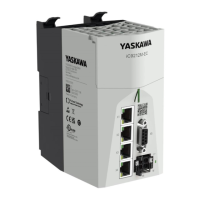HB700 | CPU | PMC921xEx | en | 24-04 175
Web-based management - WBM
Structural design
To secure communication, the same security certificate must be installed in the PC and
CPU. Y
ou transfer the certificate generated by the CPU to your PC with the following
proceeding:
1. After logging into the WBM, you can view or respectively adjust the contents of the
automatically generated certificate via ‘Configuration
🠂 Web Services’ and re-gen-
erate it with [Re-generate HTTPS certificate] . ⮫‘Web Services’...page 188
−
As soon as you change one of the IP addresses of the CPU,
you must regenerate the certificate via [Re-generate HTTPS
certificate].
2. Navigate to the certificates via ‘Security 🠂 Certificate Authentication’.
3. Switch to the tab Identity Store.
🡆 Here you have access to the generated certificate.
4. Load the requested HTTPS certificate onto your PC with . Here you can also
transfer your own existing HTTPS certificate to the CPU. ⮫
‘Certificate Authentica-
tion’...page 190
5. Install the certificate according to your Windows system as a trusted root certifica-
tion authority
.
🡆 After installation, communication between the PC and CPU takes place as a
‘secure connection’.
CAUTION
If the communication between PC and CPU is declared as an ‘insecure
connection’ during operation, either the certificate has changed, e.g. due to an
IP address change, or your system has been compromised by third parties!
Always make sure that either the current certificate of the CPU or
, if available,
an associated higher-level certificate is installed on the PC!
The WBM is divided into the following areas:
Language switching between ‘German’ and ‘English’.
Front view of the CPU with type and order designation.
Menu column for navigation.
Area for information output and input dialogs
Shows the current hardware/firmware version and MAC address of the CPU.
Access to the Yaskawa software license conditions (Software License Terms - SLT)
and the license information for the individual Linux packages.

